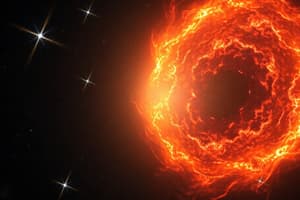Podcast
Questions and Answers
What primarily composes stars?
What primarily composes stars?
- Mercury and Argon
- Hydrogen and Helium (correct)
- Oxygen and Nitrogen
- Carbon and Sulfur
The more massive a star, the longer its lifespan.
The more massive a star, the longer its lifespan.
False (B)
Match the celestial terms with their definitions:
Match the celestial terms with their definitions:
Nebula = A cloud of gas and dust where stars are formed Protostar = An early stage of star development Main Sequence Star = A stable star that is actively fusing hydrogen into helium Nuclear Fusion = The process that powers stars by fusing lighter elements into heavier ones
What role does the Sun play in the solar system?
What role does the Sun play in the solar system?
How long does it take for light from the Sun to reach the Earth?
How long does it take for light from the Sun to reach the Earth?
What component of the solar system is primarily responsible for the gravitational force that binds the planets?
What component of the solar system is primarily responsible for the gravitational force that binds the planets?
Which of the following correctly describes the Sun's size relative to Earth?
Which of the following correctly describes the Sun's size relative to Earth?
What is the primary reason the Sun can hold all eight planets in their orbits?
What is the primary reason the Sun can hold all eight planets in their orbits?
How does light from the Sun reach the Earth?
How does light from the Sun reach the Earth?
What is the effect of the Sun's gravity on the solar system?
What is the effect of the Sun's gravity on the solar system?
What is the relative size of the Sun compared to Earth?
What is the relative size of the Sun compared to Earth?
How long does it take light from the Sun to reach the Earth?
How long does it take light from the Sun to reach the Earth?
Flashcards
Star
Star
A massive celestial body made of hydrogen and helium that produces light and heat from nuclear fusion.
Main Sequence Star
Main Sequence Star
Most stars are in this stage, undergoing stable nuclear fusion of hydrogen into helium, emitting light and heat.
Nebula
Nebula
A cloud of dust and gas where stars are born.
Nuclear Fusion
Nuclear Fusion
Signup and view all the flashcards
Protostar
Protostar
Signup and view all the flashcards
Solar System
Solar System
Signup and view all the flashcards
Sun's Size
Sun's Size
Signup and view all the flashcards
Sun's Gravity
Sun's Gravity
Signup and view all the flashcards
Light Travel Time to Earth
Light Travel Time to Earth
Signup and view all the flashcards
Sun's Distance from Earth
Sun's Distance from Earth
Signup and view all the flashcards
Solar System Components
Solar System Components
Signup and view all the flashcards
Sun's Size Compared to Earth
Sun's Size Compared to Earth
Signup and view all the flashcards
Sun's Gravity
Sun's Gravity
Signup and view all the flashcards
Light Travel Time
Light Travel Time
Signup and view all the flashcards
Sun's Distance
Sun's Distance
Signup and view all the flashcards
Study Notes
Stars and Black Holes
- Stars are huge celestial bodies, primarily hydrogen and helium, producing light and heat from nuclear reactions in their cores.
- Stars are the building blocks of galaxies. It is impossible to know exactly how many stars exist, but estimates suggest around 300 billion in the Milky Way galaxy alone.
- A star's life cycle spans billions of years, with more massive stars having shorter lifespans. Star birth occurs within dense clouds of gas and dust called nebulae.
- Nebulae collapse due to gravity, forming pockets of dense matter. One of these, a protostar, represents the start of a star's life.
- After millions of years, the core temperature of a star reaches 15 million degrees Celsius, triggering nuclear fusion. This is known as the main sequence phase, the longest stage in a star's life.
- During the main sequence, stars exist in a stable state of nuclear fusion, converting hydrogen to helium and emitting immense energy which keeps the star shining brightly.
- The Sun is categorized as a main sequence star.
- Main sequence stars also continuously radiate X-rays.
Studying That Suits You
Use AI to generate personalized quizzes and flashcards to suit your learning preferences.




